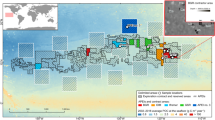Abstract
The Posht Darband stratigraphic section of the Qom Formation is considered to undertake paleontological study in the northwest of Sanandaj–Sirjan Zone, Western Iran. Field observations demonstrate that the Qom Formation is composed of medium to thick-bedded limestone (as Member "a") and alternation of sandy limestone, sandstone and green marl (as Member "b"). Based on paleontological studies the Assemblage Zone of Lepidocyclina–Operculina–Ditrupa has been recognized in the Qom Formation and there is a considerable correlation between the mentioned assemblage zone and the Zagros and European basins biozonation. Due to the lithofacies alternation of limestone to sandstone deposits in the upper portion of the Qom Formation, the abundance and variety of fauna in the Qom succession have drastically been decreased; whereas, no fossil have been found in the top of the Qom Formation. Hence, this interval of the of Qom deposits is considered as Barren Zone. Micropaleontological studies estimate the Rupelian-Chattian in age for the Qom Formation.










Similar content being viewed by others
References
Abaie I, Ansari HJ, Badakhshan A, Jaafari A (1964) History and development of the Alborz and Sarajeh fields of Central Iran. Bull Iran Pet Inst 15:561–574
Adams TD, Bourgeois F (1967) Asmari biostratigraphy Iran, Oil Operation Company, Geological Exploration. Report No. 1074:1–37
Amirshahkarami M, Naeemi M (2016) Benthic foraminifera biostratigraphy of the of the Oligocene-Miocene Qom Formation in Kahak section, Uromieh-Dokhtar Zone. Stratigraphy Sedimentol Res 63(2):91–108 (In Persian)
Anjomshoa A (2013) Biostratigraphy and microfacies of the Oligocene and Miocene deposits in Bujan section. NE of the Sirjan, M.S thesis, Shiraz Payam-Noor University, p 197 (In Persian)
Anjomshoa A, Amirshahkarami M (2013) Biostratigraphy and sedimentary model of the Late Oligocene deposits in Tanbour section SW of the Kerman. Sedimentary Facies 6(2):130–149 (In Persian)
Behforouzi E, Safari A (2011) Biostratigraphy and paleoecology of the Qom Formation in Chenar area (northwestern Kashan), Iran. Rev Mexican Cienc Geol 28(3):555–565
Bozorgnia F (1966) Qom Formation stratigraphy of the Central Basin of Iran and its intercontinental position. Bull Iran Pet Inst 24:69–75
Cahuzac B, Poignant A (1997) An attempt of biozonation of the European Basin, by means of larger neritic foraminifera. Bulletin De La Société Géologique De France 168(2):155–169
Daneshian J, Ramezani Dana L (2007) Early Miocene benthic foraminifera and biostratigraphy of Qom Formation, Deh Namak, Central Iran. Earth Sci 29(5):844–858
Ehrenberg SN, Pickard NA, Laursen GV, Monibi S, Mossadegh ZK, Svånå TA, Aqrawi AAM, McArthur JM, Thirlwall MF (2007) Strontium isotope stratigraphy of the Asmari Formation (Oligocene-Lower Miocene), SW Iran. Pet Geol 30(2):107–128
Fergusson C, Nutman AP, Mohajjel M, Bennett V (2016) The Sanandaj-Sirjan Zone in the Neo-Tethyan suture, western Iran: Zircon U-Pb evidence of late Palaeozoic rifting of northern Gondwana and mid-Jurassic orogenesis. Gondwana Res 40:43–57
Furrer MA, Soder PA (1955) The Oligo–Miocene marine Formation in the Qom region (Central Iran). In: Proceedings of 4th World Petrology Congress. Roma, section I/A/5, 267–277
Ghasemi A, Talbot CJ (2006) A new tectonic scenario for the Sanandaj-Sirjan Zone (Iran). Asian Earth Science 26:683–693
Hassanzadeh J, Wernicke BP (2016) The Neotethyan Sanandaj-Sirjan Zone of Iran as an archetype for passive margin-arc transitions. Tectonics 35:586–621. https://doi.org/10.1002/2015TC003926
Karevan M, Mahboobi A, Vaziri Moghadam H (2013) Microfacies analysis and sequence stratigraphy of the Qom Formation NE of Delijan. Ulumi - Zamin 24(94):237–248 (In Persian)
Laursen GV, Monibi S, Allan TL, Pickard NA, Hosseiney A, Vincent B, Hamon Y, Van Buchem FH, Moallemi A, Driullion G (2009) The Asmari Formation revisited: changed stratigraphic allocation and new biozonation. In: Shiraz First international petroleum conference and exhibition. Iran, pp 4–6
Loeblich AR, Tappan JH (1988) Foraminiferal genera and their classification. Van Nostrand Reinhold Company
Loftus WK (1855) On the geology of portions of the Turko-Persian frontier, and of the districts adjoining. Q J Geol Soc Lond 11:247–344
Mohajjel M, Fergusson CL (2000) Dextral transpression in Late Cretaceous continental collision Sanandaj-Sirjan Zone, Western Iran. Structural Geol 22:1125–1139
Okhravi R, Amini A (1998) An example of mixed carbonate pyroclastic sedimentation (Miocene, Central Basin, Iran). Sed Geol 118(1):37–54
Rahiminejad AH, Yazdi M, Ashouri AR (2011) Miocene scleractinian corals from a mix siliciclastic–carbonate system: Bakhtiari succession, Zagros Basin (central western Iran). Alcheringa 35:571–592
Roozpeykar A, Maghfouri Moghadam I (2015) Benthic foraminifera as biostratigraphical and paleoecological indicators, an example from Oligo-Miocene deposits in the SW of Zagros Basin, Iran. Geosci Front 7:125–140
Schuster F, Wielandt U (1999) Oligocene and Early Miocene coral faunas from Iran: paleoecology and paleobiogeography. Int J Earth Sci 3:571–581
Stöcklin J (1968) Structural history and tectonics of Iran: a review. Am Assoc Pet Geol 52:1229–1258
Takin M (1972) Iranian geology and continental drift in the Middle East. Nature 235:147–150
Toraby H (2003) Stratigraphy of Oligocene-Miocene Sediments (Qom Formation), West Ardestan-North Nain. PhD. Dissertation. University of Isfahan
Wynd J (1965) Biofacies of the Iranian consortium agreement area. Iranian Oil Offshore Company Report No. 1082
Yazdi M, Shirazi MP, Rahiminejad AH, Motavalipoor R (2012) Paleobathymetry and paleoecology of colonial corals from the Oligocene-Early Miocene (?) QomFormation (Dizlu area, central Iran). Carbonates Evaporites 27(3):395–405
Author information
Authors and Affiliations
Corresponding author
Additional information
Publisher's Note
Springer Nature remains neutral with regard to jurisdictional claims in published maps and institutional affiliations.
Rights and permissions
About this article
Cite this article
Noroozpour, H. A report from the Oligocene Qom Formation benthic foraminifera; northwest of the Sanandaj–Sirjan Zone; Western Iran. Carbonates Evaporites 36, 39 (2021). https://doi.org/10.1007/s13146-021-00710-z
Accepted:
Published:
DOI: https://doi.org/10.1007/s13146-021-00710-z




